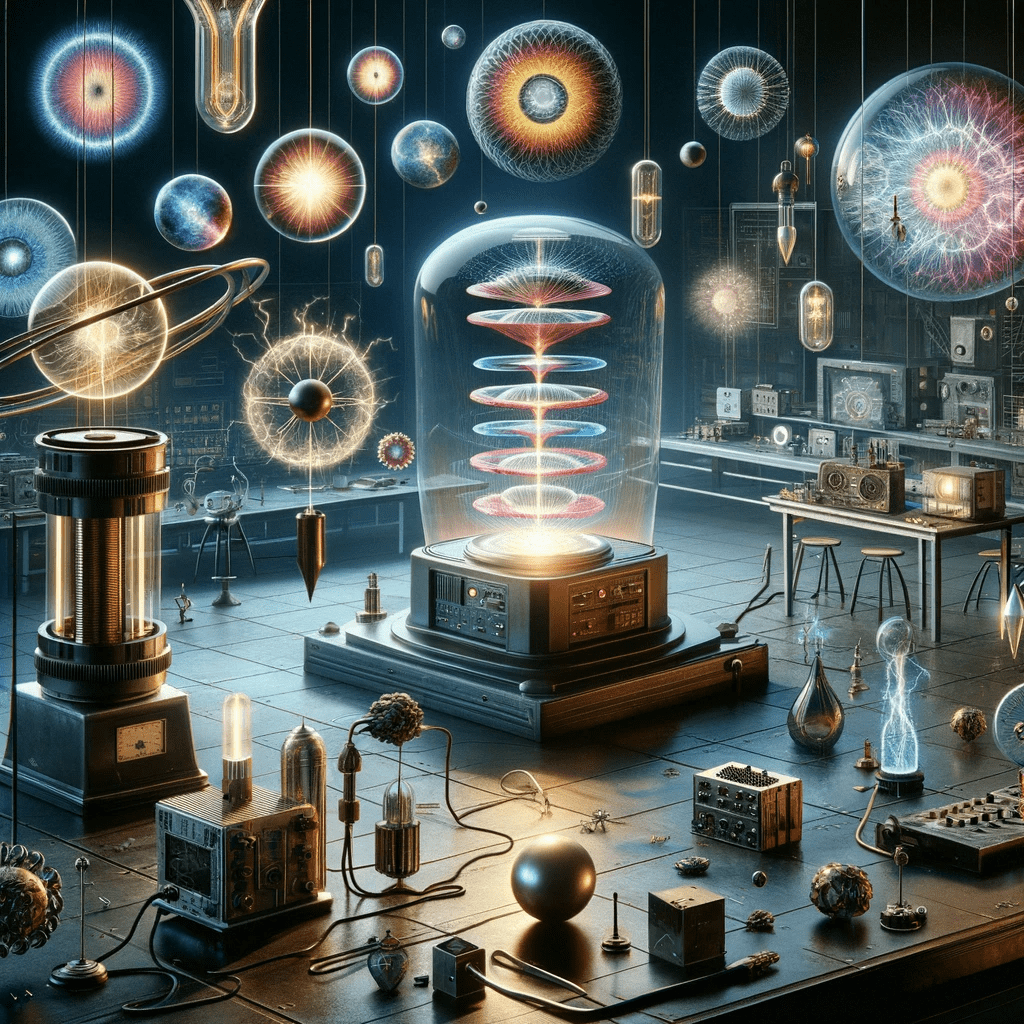The Hutchison Effect

The Hutchison Effect is a fascinating and controversial phenomenon that has captured the attention of scientists, engineers, and enthusiasts alike. Named after its discoverer, Canadian inventor John Hutchison, this effect is said to manifest through an array of extraordinary occurrences, including levitation, the fusion of dissimilar materials, and the spontaneous fracturing of metals. These phenomena, Hutchison claims, arise from the interaction of various electromagnetic fields, which he generates using an assortment of high-frequency radio equipment.
John Hutchison’s experiments began in his Vancouver, Canada workshop in the late 1970s, where he utilized a complex setup of Tesla coils, Van de Graaff generators, and other electromagnetic apparatus to produce what he believed to be anomalous physical effects. According to Hutchison, these devices emitted frequencies that interfered with the natural forces holding objects together, resulting in behaviors that seemed to defy conventional physics. The exact mechanisms underlying the Hutchison Effect remain unclear, but some theorists speculate that it may be linked to scalar waves, zero-point energy, or even quantum entanglement.
The Hutchison Effect has drawn interest from both civilian researchers and military organizations. In the 1980s, the United States military took note of Hutchison’s claims, prompting a team led by Lieutenant Colonel John B. Alexander to visit his laboratory. Alexander’s book, Future War: Non-Lethal Weapons in Twenty-First-Century Warfare (St. Martin’s Press, 1999), recounts that while some unusual effects were observed, the team sought to better understand their exact cause. The potential implications of Hutchison’s findings intrigued military and aerospace sectors, leading to sporadic collaborations and further investigations.
A 2005 paper by Canadian engineer and physicist Dr. George Hathaway, titled The Hutchison Effect: A Lift and Disruption System, was published in the AIAA Journal of Spacecraft and Rockets. Hathaway conducted a series of experiments to examine the validity of the Hutchison Effect, reporting that some phenomena were observed. He concluded that more extensive research was required to understand the underlying principles governing these effects.
Filmmaker Chris Toussaint further explored the Hutchison Effect in his 2006 documentary The Hutchison Effect: An Investigation. The film features interviews with several experts, including Dr. Elizabeth Rauscher, a former NASA consultant and physicist. Rauscher suggested that Hutchison’s experiments might have revealed an undiscovered type of radiation with potential applications in various fields, such as medicine and energy production. Another notable researcher, Dr. Hal Puthoff, co-founder of the Institute for Advanced Studies at Austin, has stated that the Hutchison Effect could represent a new form of energy, with significant implications for future technologies.
Several books have discussed the Hutchison Effect, most notably Lynne McTaggart’s The Field (HarperCollins, 2002). In her book, McTaggart explores the concept of a unifying energy field that interconnects all things, proposing that the Hutchison Effect might serve as evidence of this force’s influence on matter. She interviewed researchers like Puthoff, who advocate for continued investigation into Hutchison’s work as a potential gateway to new scientific breakthroughs.
Beyond the Hutchison Effect, John Hutchison has experimented with various unconventional technologies. His work includes:
- Crystal power cells: Hutchison developed experimental power cells composed of specially treated crystals, which he claimed could generate electricity via a process known as “cold electricity.” This process purportedly harnesses energy from the environment without producing heat, offering a potential alternative to traditional power sources.
- Free energy devices: He has designed and tested devices that he asserts can generate free energy. One such invention, the “Hutchison Converter,” is said to transform low-frequency electromagnetic waves into usable electrical power.
- Anti-gravity experiments: In addition to the levitation effects associated with the Hutchison Effect, Hutchison has conducted independent research into electromagnetic propulsion. He has developed devices using rotating magnetic fields in an attempt to achieve propulsion effects.
- Electromagnetic shielding: Hutchison has explored materials and devices aimed at shielding against electromagnetic radiation. His interest in this area reportedly stems from his personal sensitivity to electromagnetic fields, which he attributes to years of exposure to high-powered radiofrequency equipment.
One of the most remarkable demonstrations of the Hutchison Effect occurred in 1988, when an 80-pound ball was observed levitating for nearly ten minutes, seemingly defying gravity. Hutchison achieved this effect by overlapping radio waves with high-voltage spark discharges, producing a phenomenon that remains unexplained. Alongside levitation, his experiments have reportedly induced spontaneous metal fracturing, unusual energy distortions, and unexplained material fusions. Footage from this demonstration continues to generate debate over the potential manipulation of electromagnetic forces and their implications for advanced propulsion and anti-gravity research.
In 2002, John Hutchison appeared on Coast to Coast AM with Art Bell, discussing his accidental discovery of the Hutchison Effect—a series of unexplained physical phenomena attributed to his experiments with Tesla-based electromagnetic fields. Hutchison described how, in 1979, he began replicating high-frequency and electrostatic energy setups similar to Tesla’s work and inadvertently observed objects levitating, metals turning to jelly, and even the spontaneous fracturing of materials. Over the years, his experiments were reportedly witnessed by numerous scientists, engineers, and government agencies, including Boeing and the Canadian Department of Defense. Hutchison explained that his setup included multiple Tesla coils, electrostatic generators, and RF sources tuned to specific frequencies, creating an interaction between electromagnetic fields that he believed caused anomalies such as levitation and material transmutation.
During the interview, Art Bell played video footage showcasing metal wrenches, bottles, and even larger objects lifting off surfaces or behaving in ways that defied conventional physics. Some of these effects were also recorded on film and analyzed by research institutions, including Los Alamos National Laboratory. Hutchison recounted one particularly bizarre incident in which an insurance agent arrived to inspect his lab, only to claim he found an empty lot instead of a building—anecdotal evidence suggesting possible invisibility effects akin to those rumored in the Philadelphia Experiment. He also mentioned reports of a telephone pole moving several feet due to his experimental fields.
Hutchison’s work drew interest from various aerospace and military entities, and he suggested that organizations such as Lockheed Martin’s Skunk Works were continuing research based on his discoveries. He hinted at potential military applications, including propulsion and invisibility, though he admitted that the full nature of his effect remained elusive. Despite high-profile interest, his laboratory faced setbacks; in the late 1980s, the Canadian government seized much of his equipment, and an attempt to move operations to Germany was blocked. He attributed these interventions to commercial and defense interests attempting to control or suppress his work. Hutchison’s combination of scientific curiosity, unconventional methods, and dramatic claims left many intrigued and skeptical, but the physical evidence—whether due to electromagnetic interactions or an undiscovered phenomenon—remains a topic of fascination.
John Hutchison detailed the dramatic sequence of events that led to the seizure of his laboratory equipment by Canadian authorities. After being removed from his own company, Hutchison attempted to transfer his experimental setup to Germany, where a team of scientists had arranged for its relocation. However, during the packing process, law enforcement and government officials intervened, citing the presence of polychlorinated biphenyls (PCBs) as justification for the confiscation. Despite efforts by journalists and legal teams to uncover the truth, it became apparent that the stated environmental concerns were merely a pretext. This incident made front-page news in The Vancouver Sun on February 22, 1990, exposing the unusual circumstances surrounding the case.
While in Germany, Hutchison found himself at the center of even greater intrigue. Interpol agents raided the house where he was staying, under the suspicion that he had been kidnapped by East Bloc operatives. After an investigation, they concluded that he was there of his own free will. Meanwhile, back in Canada, he was warned that returning to Vancouver could lead to his arrest. When he eventually did return, he met with government officials who showed him documentation of the seizure but curiously offered to return non-essential testing equipment, excluding anything related to Tesla’s research. Hutchison was infuriated by the apparent deception, realizing that the authorities had been primarily interested in extracting whatever knowledge they could from his work rather than addressing any genuine environmental concerns.
Throughout the interview, Art Bell fielded calls from listeners fascinated by the implications of Hutchison’s experiments. Some suggested that his discoveries could have been used for advanced propulsion systems, weapons applications, or even as an explanation for the construction of ancient monuments like the pyramids. Others speculated about potential connections to zero-point energy, the Philadelphia Experiment, and Area 51. Hutchison confirmed that his work had drawn interest from military and aerospace organizations, including Lockheed Martin’s Skunk Works, and that his research had been cited in the context of advanced propulsion studies at NASA. However, he expressed reluctance to see his discoveries militarized, preferring applications in space travel or environmental cleanup, particularly regarding the neutralization of radioactive waste.


